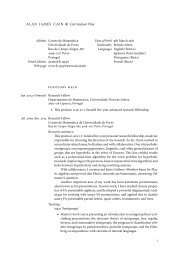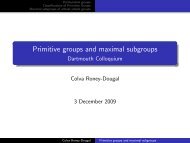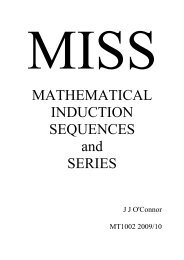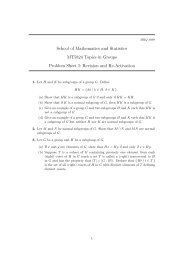Malcev presentations for subsemigroups of direct products of ...
Malcev presentations for subsemigroups of direct products of ...
Malcev presentations for subsemigroups of direct products of ...
Create successful ePaper yourself
Turn your PDF publications into a flip-book with our unique Google optimized e-Paper software.
<strong>of</strong> two free semigroups, but Theorem shows that such <strong>direct</strong> <strong>products</strong> are notin general <strong>Malcev</strong> coherent: the <strong>direct</strong> product <strong>of</strong> two free semigroups <strong>of</strong> rankat least 2 is not <strong>Malcev</strong> coherent.The <strong>Malcev</strong> coherence <strong>of</strong> nilpotent groups was established by [CRRa, Theorem]. Polycyclic groups <strong>for</strong>m a more general class than finitely generatednilpotent groups whilst retaining the property <strong>of</strong> coherence [Sim, §§ .–.].One there<strong>for</strong>e naturally asks whether polycyclic groups are <strong>Malcev</strong> coherent.From Theorem and a result <strong>of</strong> Rosenblatt [Ros], one obtains a negative answer:polycyclic groups are not in general <strong>Malcev</strong> coherent.The <strong>direct</strong> product <strong>of</strong> a free group and an abelian group is coherent. (Aslight modification <strong>of</strong> the reasoning <strong>of</strong> [Mil] proves this assertion and, moregenerally, establishes the coherence <strong>of</strong> the <strong>direct</strong> product <strong>of</strong> a free group and apolycyclic group.) Both virtually free groups [CRRb, Theorem ] and abeliangroups are known to be <strong>Malcev</strong> coherent. [Every finitely generated subsemigroup<strong>of</strong> an abelian group — and more generally every finitely generated commutativesemigroup — admits a finite ‘ordinary’ presentation as a consequence<strong>of</strong> Rédei’s Theorem [Réd].] Most <strong>of</strong> this paper is dedicated to the pro<strong>of</strong> <strong>of</strong> itssecond main result, Theorem , which asserts that every <strong>direct</strong> product <strong>of</strong> avirtually free group and an abelian group is <strong>Malcev</strong> coherent.[This paper is based on Chapter <strong>of</strong> the author’s Ph.D. thesis [Cai].] Following [ECH + ], the notation used in this paper distinguishesa word from the element <strong>of</strong> the semigroup or group it represents. Let A be analphabet representing a set <strong>of</strong> generators <strong>for</strong> a semigroup S. For any word w ∈A + , denote by w the element <strong>of</strong> S represented by w. Similarly, if A representsa set <strong>of</strong> generators <strong>for</strong> a group G, let w be the element <strong>of</strong> G represented byw ∈ (A ∪ A −1 ) ∗ . In both cases, <strong>for</strong> any set <strong>of</strong> words W, W is the set <strong>of</strong> allelements represented by at least one word in W.The theory <strong>of</strong> <strong>Malcev</strong> <strong>presentations</strong> was introduced by Spehner [Spe], thoughthey are based on <strong>Malcev</strong>’s necessary and sufficient condition <strong>for</strong> the embeddability<strong>of</strong> a semigroup in a group [Mal, Mal]. (Details <strong>of</strong> the embeddabilitycondition can also be found in [CP, Chapter ].) Although this sectioncontains the definitions and results about <strong>Malcev</strong> <strong>presentations</strong> required <strong>for</strong> therest <strong>of</strong> the paper, the reader is assumed to be familiar with the basic theory <strong>of</strong>[ordinary] semigroup <strong>presentations</strong>. For a fuller exposition <strong>of</strong> the foundations<strong>of</strong> the theory <strong>of</strong> <strong>Malcev</strong> <strong>presentations</strong>, see [Cai, Chapter ]. . Let S be any semigroup. A congruence σ on S is a <strong>Malcev</strong>congruence if S/σ is embeddable in a group.If {σ i : i ∈ I} is a set <strong>of</strong> <strong>Malcev</strong> congruences on S, then σ = ∩ i∈I σ i is alsoa <strong>Malcev</strong> congruence on S. This is true because S/σ i embeds in a group G i <strong>for</strong>each i ∈ I, so S/σ embeds in ∏ i∈I S/σ i, which in turn embeds in ∏ i∈I G i. Thefollowing definition there<strong>for</strong>e makes sense. . Let A + be a free semigroup; let ρ ⊆ A + × A + be any binaryrelation on A + . Denote by ρ M the smallest <strong>Malcev</strong> congruence containing ρ —namely,ρ M = ∩ {σ : σ ⊇ ρ, σ is a <strong>Malcev</strong> congruence on A+ } .














